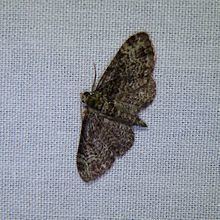Higher classification Eupithecia | Family Geometridae Scientific name Eupithecia subfuscata Rank Species | |
 | ||
Similar Eupithecia, Butterflies and moths, Tawny speckled pug, Juniper pug, Eupithecia tripunctaria | ||
The grey pug (Eupithecia subfuscata) is a moth of the family Geometridae. It is found throughout the Palearctic region and the Near East. It is also found in North America.
Contents
The forewings of this species are grey (ccasionally with an ochreous tinge) marked with pale fascia and radial lines which give it a mottled appearance.There is a pale sub-marginal line and a small discal spot.The hindwings are much paler and plainer also with a small black discal spot. Melanism is quite common in this species. The wingspan is 17–21 mm.
The adults fly in May and June with a second brood sometimes emerging in August. The species flies at night and is attracted to light.
The larva feeds on the leaves and flowers of a wide range of plants (see list below). The species overwinters as a pupa.
